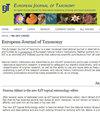European net-winged beetles of the Pyropterus clade, with the description of Gomezzuritus gen. nov. (Coleoptera: Lycidae)
IF 1.3
3区 生物学
Q3 ENTOMOLOGY
引用次数: 0
Abstract
We simultaneously considered morphology and molecular phylogeny to modify the generic classification of the ‘pyropterine clade’ (Lycidae, Erotinae, Dictyopterini). To place species previously included in Benibotarus Kôno, 1932 in reciprocally monophyletic genera, we propose Gomezzuritus gen. nov. with the type-species Dictyopterus alternatus Fairmaire, 1856. Further, we transfer Gomezzuritus alternatus (Fairmaire, 1856) comb. nov., G. longicornis (Reiche, 1878) comb. nov., and G. rubripes (Pic, 1897) comb. nov. from Benibotarus to Gomezzuritus gen. nov. The pyropterine clade contains five genera in the Palaearctic region: Pyropterus Mulsant, 1838, Gomezzuritus gen. nov., Helcophorus Fairmaire, 1891, Greenarus Kazantsev, 1995, and Benibotarus Kôno, 1932. The arrangement of longitudinal elytral costae proved misleading for consideration of relationships. Two genera in distant positions share only four primary costae (Pyropterus and Helcophorus), and three similarly distant genera share the shortened primary costa 3, resulting in three primary and four secondary longitudinal costae (Gomezzuritus, Greenarus, and Benibotarus). The larva of Gomezzuritus alternatus is described in detail, and it is compared with the larvae of other Dictyopterini, including the presumed larva of G. longicornis.欧洲焦翅目网翅甲虫记述(鞘翅目:鞘翅科)
我们同时考虑形态学和分子系统发育来修改“焦翅虫枝”的一般分类(Lycidae, Erotinae, Dictyopterini)。为了将以前包括在Benibotarus Kôno, 1932中的物种置于相互单系属中,我们提出了gomzzuritus gen. 11 .和Dictyopterus alternatus Fairmaire, 1856的模式种。此外,我们转移了gomez zzuritus alternatus (Fairmaire, 1856)梳子。11 ., G. longicornis (Reiche, 1878)梳子。11月,和G. rubripes(图片,1897)梳子。在古北极地区,焦翅虫进化支包括5个属:焦翅虫,1838年,焦翅虫,1838年,焦翅虫,1891年,焦翅虫,1891年,绿头虫,1995年,焦翅虫Kôno, 1932年。纵向鞘翅的排列被证明会误导考虑关系。距离较远的两个属共用四个初级肋条(Pyropterus和Helcophorus),而距离较远的三个属共用缩短的初级肋条3,导致三个初级肋条和四个次级纵肋条(gomzzuritus, Greenarus和Benibotarus)。本文详细描述了黄纹革螨的幼虫,并将其与其他革螨的幼虫进行了比较,其中包括推测为长角革螨的幼虫。
本文章由计算机程序翻译,如有差异,请以英文原文为准。
求助全文
约1分钟内获得全文
求助全文
来源期刊

European journal of taxonomy
ZOOLOGY-
CiteScore
2.30
自引率
8.30%
发文量
173
审稿时长
29 weeks
期刊介绍:
EJT is a fully refereed, international, fully electronic Open Access journal in descriptive taxonomy, covering subjects in zoology, entomology, botany (in its broadest sense), and palaeontology. EJT-papers must be original and adhere to high scientific (content) and technical (language, artwork, etc.) standards. Manuscripts that are clearly substandard in either of these categories will not be sent out for review. EJT is supported by a consortium of European Natural History Institutes, but its scope is global. Both authorship and geographical region of study need not be European. Authors are, however, strongly encouraged to involve European Natural History collections by consulting material or by depositing specimens (e.g. types and figured material) related to their published paper in the collection of a European Natural History Institute.
 求助内容:
求助内容: 应助结果提醒方式:
应助结果提醒方式:


